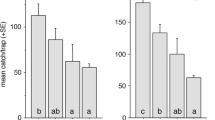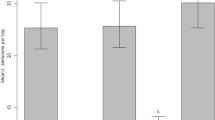Abstract
Uptake and release of pheromone and behavioral inhibitor ofEpiphyas postvittanna by apple leaves was tested using field electroantennograms (EAG), trap catches to synthetic lures and virgin females, and chemical analysis. Trap catches in single apple trees (N=3) were monitored for six cycles of six days' duration, using delta traps baited with synthetic pheromone. Polyethylene dispensers (0, 1, 10 per tree) releasing pheromone and inhibitor were present for only the first three days of each cycle. Application of 10 dispensers per tree resulted in complete disruption of trapping, which continued for one day after dispensers were removed. Over the three nights following the removal of the dispensers (days 4–6), trap catch was 0, 10, and 15% of the control catch. In contrast, the presence of only one dispenser per tree led to 0–20% of control catches, but on the three nights following dispenser removal catches were 35, 40, and 80% of the control catch. Field EAGs indicated significantly higher relative pheromone concentrations in the trees with 10 dispensers present, compared to trees with single dispensers, but removal of dispensers produced no detectable treatment effect compared to the control trees one day after dispenser removal. In a second experiment, releases of marked male moths into apple orchard plots following the removal of polyethylene dispensers (1 hr earlier that day) resulted in significantly lower catches in traps baited with virgin females in blocks that had been treated, compared to controls. Recovery of pheromone by solvent washing of leaves loaded with 50 µg of the main component of the sex pheromone (1.26 µg/cm2) was low (2.5%). Leaves held in a pheromone-saturated atmosphere were loaded with 0.045±0.007 µg pheromone/cm2. Analysis of apple leaves taken from a pheromone-treated tree at different distances from the pheromone dispenser showed a decay of the pheromone load per square centimeter with increasing distance from the dispenser, as previously indicated by EAG.
Similar content being viewed by others
References
Baker, A.E. 1982. Chemistry and morphology of plant epicuticular waxes, pp. 139–165,in D.F. Cutler, K.L. Alvin, and E. Price (eds.). The Plant Cuticle. Academic Press, London.
Baker, T.C. Willis, M.A., Haynes, K.F., andPhelan, P.L. 1985. A pulsed cloud of sex pheromone elicits upwind flight in male moths.Physiol. Entomol. 10:257–265.
Bartell, R.J., andLawrence, L.A. 1973. Reduction of responsiveness ofEpiphyas postvittana (Lepidoptera) to sex pheromone following previous brief pheromonal exposure.J. Insect Physiol. 19:845–855.
Bellas, T.E., Bartell, R.J., andHill, A. 1983. Identification of the two components of the sex pheromone of the moth,Epiphyas postvittana (Lepidoptera, Tortricidae).J. Chem. Ecol. 9:503–512.
Bengtsson, M., Karg, G., Kirsch, P.A. Löfqvist, J., Sauer, A.E., andWitzgall, P. 1994. Mating disruption of the pea mothCydia nigricana F. (Lepidoptera, Tortricidae) with a repellent blend of sex pheromone and attraction inhibitors.J. Chem. Ecol. 20:871–887.
Bradley, S.J., Suckling, D.M., Mcnaughton, K.G., Wearing, C.H., andKarg, G. 1995. A temperature dependent model for predicting release rates of pheromones from polyethelene tubing dispensers.J. Chem. Ecol. 21:745–760.
Fernandes, A.M.S., Batt, R.F., andMartin, J.T. 1964. The cuticular waxes of apple leaves and fruit and the cuticles of pear fruits during growth. Report of Long Ashton Research Station for 1963, University of Bristol, U.K.
Hansson, B.S., Van der Pers, J.N.C., andLöfqvist, J. 1989. Comparison of male and female olfactory cell response to pheromone components and plant volatiles in the turnip moth,Agrotis segetum.Physiol. Entomol. 14:147–155.
Hrdy, I., Borek, V., Kalinov, B., Kudlov, J., andVrcoc, J. 1990. Male confusion of the oriental fruit mothCydia molesta, and the plume fruit moth,Cydia funebrana: Small trials of pheromone dispensers, pp. 401–406,in Proceedings, Conference on Insect Chemical Ecology. Tábor, Czechoslovakia.
Hurlbert, S.H. 1984. Pseudoreplication and the design of ecological field experiments.Ecol. Monogr. 54:187–211.
Jeffree, C.E. 1986. The cuticle, epicuticular waxes and trichomes of plants, with references to their structure, function and evolution, pp. 23–64,in B.E. Juniper and T.R.E. Southwood (eds.). Insect and the Plant Surfaces. Edward Arnold, London.
Karg, G., andSauer, A.E. 1992. The structure of the odour plume in a vineyard treated for mating disruption of the grape vine mothLobesia botrana, pp. 296–297,in Pest Control and Sustainable Agriculture. Proceedings of the Fifth Australian Applied Entomological Research Conference (April 27–May 1). Canberra, ACT, Australia.
Karg, G., andSaur, A.E. 1995. Spatial distribution of pheromone in vineyards treated for mating disruption of the grape vine mothLobesia botrana measured with electroantennograms.J. Chem. Ecol. In press.
Karg, G., Sauer, A.E., andKoch, U.T. 1990. The influence of plants on the development of pheromone atmospheres measured by EAG method, p. 301,in R. Elsner and W. Singer (eds.). Brain-Perception-Cognition. Proceedings of the 18th Göttingen Neurobiology Conference. George Thieme Verlag, Stuttgart.
Karg, G., Suckling, D.M., andBradley, S.J. 1994. Absorption and release of pheromone ofEpiphyas postvittana (Lepidoptera: Tortricidae) by apple leaves.J. Chem. Ecol. 20:1825–1841.
Kennedy, J.S., Ludlow, A.R., andSanders, C.J. 1981. Guidance of flying moths by wind-borne sex pheromone.Physiol. Entomol. 6:221–240.
Murlis, J. 1986. The structure of odour plumes. pp. 27–38,in T.L. Payne, M. C. Birch, and C.E.J. Kennedy (eds.). Mechanisms of Insect Olfaction. Oxford University Press, New York.
Murlis, J., andJones, C.D. 1981. Fine-scale structure of odour plumes in relation to insect orientation to distant pheromone and other attractant sources.Physiol. Entomol. 6:71–86.
Murlis, J., Elkinton, J.S., andCardé, R.C. 1992. Odor plumes and how insects use them.Annu. Rev. Entomol. 37:505–532.
Noldus, L.P.J.J., Potting, R.P.J., andBarendrengt, H.E. 1991. Moth sex pheromone adsorption to leaf surfaces: Bridges in time for chemical spies.Physiol. Entomol. 16:329–344.
Rumbo, E.R., Deacon, S.M., andRegan, L.P. 1993. Spatial discrimination between natural pheromone and inhibitor in the lightbrown apple mothEpiphyas postvittana (Walker) (Lepidoptera: Tortricidae).J. Chem. Ecol. 19:953–962.
Rumbo, E.R., Suckling, D.M., andKarg, G. 1995. Measurements of airborne pheromone concentrations using EAG equipment: Interactions between environmental volatiles and pheromone.Physiol. Entomol. 41:465–471.
Sivinski, J.M., Epsky, N., Health, R.R. 1994. Pheromone deposition on leaf territories by male Caribbean fruit flies,Anastrepha suspensa (Loew) (Diptera: Tephritidae).J. Insect Behav. 7:43–51.
Suckling, D.M., andShaw, P.W. 1990. Preliminary trials of mating disruption of lightbrown apple moth in Nelson, pp. 311–316,in Proceedings, 43rd New Zealand Weed and Pest Control Conference.
Suckling, D.M., andShaw, P.W. 1991. Evaluation of mationg disruption of lightbrown apple moth in Nelson, pp. 47–51,in Proceedings, 44rd New Zealand Weed and Pest Control Conference.
Suckling, D.M., andShaw, P.W. 1995. Large scale trials of mating disruption of light brown apple moth.N.Z. J. Crop Hortic. Sci. 23:127–137.
Suckling, D.M., Shaw, P.W., Khoo, J.G.I., andCruickshank, V. 1990a. Resistance management ofEpiphyas postvittana (Lepidoptera: Tortricidae) using mating disruption.N.Z. J. Crop. Hortic. Sci. 18:89–98.
Suckling, D.M., Khoo, J.G.I., andRogers, D.J. 1990b. Disruption of lightbrown apple mothEpiphyas postvittana (Lepidoptera: Tortricidae) trapping in Nelson. New Zealand.Aust. J. Zool. 38:363–373.
Suckling, D.M., Karg, G., Bradley, S.J., andHoward, C.R. 1994. Field electroantennogram and behavioral responses ofEpiphyas postvittana (Lepidoptera: Tortricidae) under low pheromone concentrations.J. Econ. Entomol. 87:1477–1487.
Wall, C., andPerry, J.N. 1983. Further observations on the responses of male pea moth,Cydia nigricana, to vegetation previously exposed to sex-attractant.Entomol. Exp. Appl. 33:112–116.
Wall, C., Sturgeon, D.M., Greenway, A.R., andPerry, J.N. 1981. Contamination of vegetation with synthetic sex attractant released from traps for the pea moths.Cydia nigricana.Entomol. Exp. Appl. 30:111–115.
Willis, M.A., andBaker, T.C. 1984. Effects of intermittent and continuous pheromone stimulation on the flight behavior of the oriental fruit moth,Grapholita molesta.Physiol. Entomol. 9:341–358.
Zar, J.H. 1984. Biostatistical Analysis. Prentice-Hall, London, 718 p.
Author information
Authors and Affiliations
Rights and permissions
About this article
Cite this article
Suckling, D.M., Karg, G. & Bradley, S.J. Apple foliage enhances mating disruption of light-brown apple moth. J Chem Ecol 22, 325–341 (1996). https://doi.org/10.1007/BF02055102
Received:
Accepted:
Issue Date:
DOI: https://doi.org/10.1007/BF02055102




